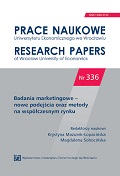Segmentacja łańcuchów środków-celów: miary podobieństwa sekwencji i ilościowe wskaźniki jakości grupowania a wyniki grupowania
Segmentation of means-end chains: sequence dissimilarity measures and quantitative cluster validity indexes vs. clustering results
Author(s): Anna MyrdaSubject(s): Economy
Published by: Wydawnictwo Uniwersytetu Ekonomicznego we Wrocławiu
Keywords: market segmentation; Means-End Chains; cluster analysis; sequence dissimilarity measure; cluster validity index
Summary/Abstract: The Means-End Chains are built with qualitative and sequential data describing the cognitive-motivational structures of consumers, which can be used for market segmentation. The objective of the study is to analyse whether and how sequence dissimilarities measurement affects the properties of the selected quantitative cluster validity indexes and the final results of exploratory cluster analysis. The following measures of sequence dissimilarity were used in the grouping of 482 ladders: Hamming, the longest common subsequence, the longest common suffix and optimum matching. S cluster validity indexes were used to measure clustering goodness: silhouette, index of Baker and Hubert and index of Hubert and Levin. Based on the cluster validity indexes the model with 8 groups was selected as the best irrespective of the sequence dissimilarity measure used in the analysis.
Journal: Prace Naukowe Uniwersytetu Ekonomicznego we Wrocławiu
- Issue Year: 2014
- Issue No: 336
- Page Range: 70-78
- Page Count: 9
- Language: Polish

